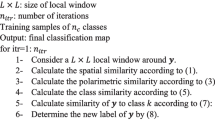Abstract
Automatic detection and recognition of targets by means of passive IR sensors suffer from limitations due to lack of sufficient contrast between the targets and their background, and among the facets of a target.
In this paper the results of a suite of polarization-sensitive automatic target detection and recognition algorithms on sets of simulated and real polarimetric IR imagery are presented. A custom designed Polarimetric IR (PIR) imaging sensor is used for collecting real polarimetric target data-three of the four Stokes parameters under a variety of conditions. Then a set of novel algorithms are designed and tested that uses the target and background Stokes parameters for detection, segmentation and classification of targets.
The empirical performance results are obtained in terms of the probabilities of detection, false alarm rate, segmentation accuracy, and recognition probabilities as functions of number of pixels on target, aspect and depression angles and under several background conditions (clutter densities) on the polarimetric and non-polarimetrirc data. These results show that a noticeable improvement over the non-polarimetric ATR can be achieved.
Similar content being viewed by others
REFERENCES
Chun, C., Fleming, C., and Torok, E.” Polarization-Sensitive Thermal Imaging,” Automatic Object Recognition IV, SPIE VOL. 2234, 1994.
Sadjadi, F.,” Automatic Target Recognition,” Special Section Guest Editorial, Optical Engineering Journal, Vol. 31,No. 12, December 1992.
Sadjadi, F.,” Automatic Object Recognition: Critical Issues and Current Approaches,” Proceedings of the International Conference on Automatic Object Recognition, SPIE Vol. 1471, 1991.
Sadjadi, F. “Automatic Object Recognition using Coding Schemes,” Optical Engineering Journal, Vol. 31,No. 12, December 1992.
Sadjadi, F., “Automatic recognition of partially occluded objects,” Proceedings of the second International Conference on Automatic Object Recognition, SPIE Vol. 1700, Orlando, Florida, April 1992.
Sadjadi, F.,” Performance Evaluation of a Textured-based segmentation Algorithm”, Proceedings of the SPIE Conference on Signal and Image Processing Systems Performance Evaluations, Simulations, and Modeling, Vol. 1483, 1991.
Sadjadi, F., Editor, Milestone Papers in Performance Evaluations of Signal and Image Processing Systems, SPIE Milestone Series, 1993.
Sadjadi, F., “Experimental Design Methodology: The Scientific Tool for Performance Evaluation,” Proceedings of the International Conference on Performance Evaluation of Signal and Image processing Systems, SPIE 1310, Orlando, Florida, April 1990
Shurcliff, W., Polarized Light, Harvard University Press, Cambridge, Massachusetts, 1960.
Wolf, L., “Advances in Polarization Vision,” Proceedings of the DARPA Image Understanding Workshop, 1994.
Flynn, D., Alexander, C., "Polarized Surface Scattering Expressed in Terms of a Bidirectional Reflectance Distribution Function Matrix," Optical Engineering Journal, Vol. 34,No. 6., June 1995.
Van De Hulst, H., Light Scattering by Small Particles, John Wiley, New York, 1957.
Author information
Authors and Affiliations
Rights and permissions
About this article
Cite this article
Sadjadi, F.A., Chun, C.S. Application of a Passive Polarimetric Infrared Sensor in Improved Detection and Classification of Targets. International Journal of Infrared and Millimeter Waves 19, 1541–1559 (1998). https://doi.org/10.1023/A:1022611310541
Issue Date:
DOI: https://doi.org/10.1023/A:1022611310541




